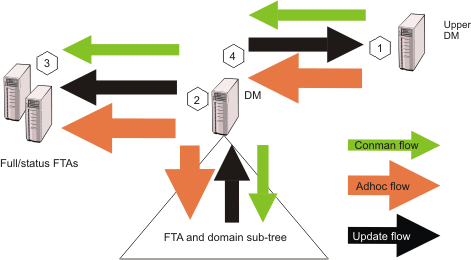Planning space for queues
In order to plan space for event queues, and possible alert levels
and reactions, it is necessary to model the flows passing through
the agents, and the domain managers in particular.
Figure 1. Typical HCL Workload Automation network
flows.

For a typical domain manager, the main flow comes from update activity
reported by the sub tree, and from ad hoc submissions arriving from
the master domain manager and
propagating to the entire network. Under these conditions, the most critical errors
are listed by order of importance in Table 1:
| Flow no. | Location | Queue | Risk | Impact |
|---|---|---|---|---|
| 1 | Upper domain manager | dm.msg | The queue fills up because of too many unlinked workstations in the domain or a downstream domain manager has failed. | The upper domain manager fails and propagates the error. |
| 2 | Domain manager | FullStatus fta.msg | The queue fills because of too many unlinked workstations in the domain or because the FullStatus fault-tolerant agent is not coping with the flow. | The domain manager fails and favors the occurrence of #1. |
| 3 | Domain manager and FullStatus fault-tolerant agent | Mailbox.msg or Intercom.msg | The queue fills because the FullStatus fault-tolerant agent cannot cope with flow. | The FullStatus fault-tolerant agent fails and favors the occurrence of #2. |
| 4 | Domain manager | tomaster.msg | The queue fills because of too many unlinked workstations in the domain. | The domain manager starts to unlink the subtree and accumulates messages in the structure. |
| 5 | Fault-tolerant agents - only when enSwfaultTol global option is set to yes | deadletter.msg | The queue fills because of too many unlinked workstations in the domain. | The agent stops. |
| 6 | Fault-tolerant agents - only when enSwfaultTol global option is set to yes | ftbox.msg | This queue is circular. The rate of messages entering the queue exceeds the rate of messages being processed, because of too many unlinked workstations in the domain. | Events are lost. |
Note:
- Flows are greater at the master domain manager and at any FullStatus fault-tolerant agents in the master domain than at subordinate domain managers or FullStatus fault-tolerant agents.
- Use evtsize -show to monitor queue sizes.
- The amount of update flow is related to the amount of workload running in a particular subtree and is unavoidable.
- The amount of ad hoc flow is related to the amount of additional workload on any point of the network. It can be reduced by planning more workload even if it is inactive. Note that simple reruns (not rerun from) do not create an ad hoc flow.
The planning, alert, and recovery strategy must take into account
the following points:
- Queue files are created with a fixed size and messages are added and removed in a cyclical fashion. A queue reaches capacity when the flow of incoming messages exceeds the outgoing flow for a sufficient length of time to use up the available space. For example, if messages are being added to a queue at a rate of 1MB per time unit and are being processed and removed at a rate of 0.5 MB per time unit, a queue sized at 10 MB (the default) is at capacity after 20 time units. But if the inward flow rate descends to be the same as the outward flow rate after 19 time units, the queue does not reach capacity.
- The risk of the domain manager failing can be mitigated by switching to the backup domain manager. In this case, the contents of the queues on the domain manager are unavailable until the domain manager backup is started. In all cases, the size of the queue on the upper domain manager towards any other domain manager must respect condition A of Table 2.
- The risk that fault-switching fault-tolerant agents might not be able to cope with the flow must be planned beforehand. The specifications for fault-switching fault-tolerant agents must be similar to those of the domain manager, to avoid that an agent receives a load that is not appropriate to its capacity. Check if a queue is forming at the FullStatus fault-tolerant agents, both in ordinary and peak operation situations.
- Once risk #2 has been dealt with, the possibility of a network link failure can be mitigated by sizing the queue from a domain manager to the FullStatus fault-tolerant agents appropriately as a function of the average network outage duration, and by increasing the size of the mailbox in case of unexpected long outage (see condition B of Table 2).
- The same condition applies for avoiding an overflow of the domain manager's tomaster.msg queue with respect to network outages (see condition C) of Table 2.
| A | MaxAlertTime <= size(UpperDM#queueToDM) / averageAdhocFlow |
| B | MaxNetOutage <= size(DM#queueToFSFTA) / (averageAdhocFlow + averageUpdateFlow) |
| C | MaxNetOutage <= size(DM#queueToUpperDM) / (averageUpdateFlow) |